
“The responsibility for involving everyone in a meeting is shared by everyone at that meeting. Everyone needs to make a commitment to work together to ensure inclusion for all.”
Pauline Williams, Co-ordinator AMIDA
Committing to Change
Committing to consumer participation involving people with cognitive disabilities within an organisation requires a shift in attitudes and the way things are traditionally done. For consumer participation to work it is important organisations actively adopt and promote the principles of respect and equality. These principles should be reflected in all activities involving consumer participation including meetings. This means:
- All people at the meeting are considered to be equal contributors and their opinions are valued.
- Consumer representative views are actively sought, listened to and considered.
- Recognising the knowledge and experience of all members.
- Fostering an environment of shared knowledge and experience.
- Treating adults as adults.
- Understanding the representative might have a distrust of professionals and be cynical about the consumer participation process.
(National Framework for Consumer Control in Cancer Control. Cancer Voices Australia, Australian Government)
Top Tips: The First Meeting
First meetings can be intimidating and nerve-racking for all of us. It is important to provide a welcoming and supportive environment as follows:
- Make sure there is someone to welcome the representative when they arrive.
- Their role should include:
- Introductions, including introducing the rep to the chair.
- Orientation – where the toilets are, where to get a coffee, etc.
- Encouraging the rep to ask questions.
- Finding out if the rep needs anything to be explained.
- Letting the consumer representative know it is OK to ask questions and to ask for help during the meeting.
- Checking the representative’s specific needs and accommodations have been addressed. For example, a quiet environment for people who experience noise intolerance, accessible building, accessible information and language, etc.
- Their role should include:
Top Tips: All Meetings
Adapted from Get On Board and Make a Difference! ARC of Vermont, Greenmont Self Advocates 2003
Be aware consumer representatives may find meetings intimidating and at times disempowering. Therefore, it is important to provide support and undertake good meeting practices from the beginning, as follows.
Practical steps to make meetings accessible
- Minimise the use of jargon and acronyms in meetings. If jargon is used, make sure it is explained in a way everyone can understand.
- Make sure all information is accessible.
- If written material is presented in the meeting that was not sent out before the meeting, read it aloud.
- Follow the agenda and explain each item, summarise the discussion and any decisions that were made.
- Before you move on to the next item it is important to ask each person individually if they have anything more they would like to add.
- Don’t jump from item to item or drift off the topic as it can be confusing for everyone.
- Slow down, make sure the meeting is not too fast.
- Ensure only one person speaks at a time and people don’t talk over each other.
- Take regular breaks throughout the meeting.
Encourage active participation
- Ensure everyone has an opportunity to speak and participate in discussions.
- Allow people time to ask questions, express their view points, including the new members.
- Listen and explore everyone’s ideas equally.
- Ensure people are able to have their say without being interrupted.
- Allow time for explanations for people to process information and think about their response.
- Avoid speaking for others – encourage people to speak on their own behalf.
- Regularly ask if people have any questions.
- Give people permission to interrupt and ask for explanations of anything they don’t understand
- Be aware it may take several meetings before people feel confident to speak up and have their say.
- Don’t jump to conclusions about what a person is saying and speak before they finish.
- Be mindful of your body language, tone of voice and other gestures that may influence a person’s decision.
- Use open-ended questions rather than yes/no type questions.
- Let people know it is ok to disagree.
- Speak to the consumer representative with a disability not their support worker or mentor.
- Do not make assumptions about inability to understand or participate. If in doubt, ask!
Meeting Tips from consumer advocates:
Amanda’s Top Tips
Brain Injury Matters’ Top Tips
Next Page: Inclusive Meetings – Help Everyone Understand
Chapter 5. Inclusive Meetings
Menu: Consumer Participation Kit



